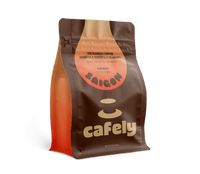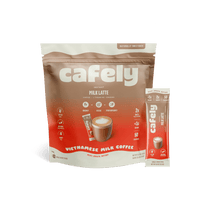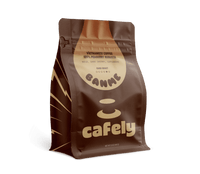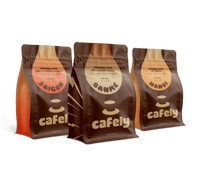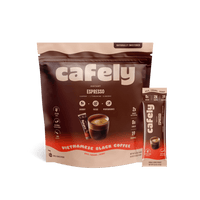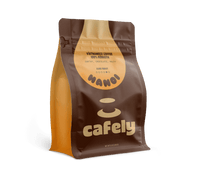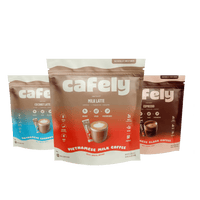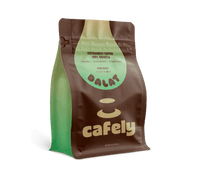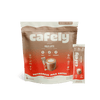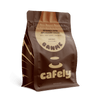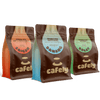Ever wonder why cafe coffee tastes so much better than what you brew at home? It’s not just high-tech espresso machines — it’s the beans. Fresh, high-quality coffee beans can transform your morning cup, but knowing where to buy them is half the battle.
Read on to find out where to buy the best coffee beans and how to choose the right blend for you.
Where to Buy Coffee Beans
If you’re starting to track down top-notch coffee beans, you’d be forgiven for getting overwhelmed. There are many vendors and types of coffee beans out there it can be difficult to know where to start.
There are many things to consider when looking for where to buy coffee beans from. Let’s talk about some great places you can get impressive coffee beans from to get started.
Online Stores
Buying the best coffee online gives you direct access to passionate roasters, some of the best coffee brands in the world, better prices, and a wider variety of beans than most supermarkets offer — including unique options like Vietnamese coffee.
Online stores often sell fresher, single-origin beans with more roast variety, while grocery store coffee is typically older and less flavorful. Dark roast fans especially benefit, as reputable online brands preserve the rich, caramelized sweetness that’s often lost in stale, over-roasted supermarket coffee.
Coffee Shops

Coffee shops are great for sampling brews and buying beans from your favorite drinks. However, they often have a limited selection — usually just their house blend.
If you're looking to explore a wider variety, online stores with the best coffee subscriptions and multi-packs offer more options.
Specialty Coffee Stores
While stores dedicated to coffee and the accouterment that goes with it are rare, you may be lucky enough to live near one. These specialty shops typically sell a wide range of coffee beans roasted to perfection and may even roast coffee on-site.
In that case, it would be wise to try a few options — freshness has a huge impact on coffee’s flavor, so getting something extremely fresh can lead to a stellar cup of coffee.
The main disadvantage of these stores is their rarity and, often, their cost — if you live in a large city, there may be a few coffee roasters selling their beans and the price will likely be premium.
How to Find a Good Coffee Vendor
Let’s say you’ve found a coffee bean you particularly like. You research the bean and roast type and get a list of vendors who sell them. How do you tell which ones you should go with?
It can be tempting to base that decision solely on price, but let’s go through some other key factors.
1. A Select Product Range
When approaching a coffee vendor, think of their product range like a menu in a restaurant. While they can have a thick book that’s overflowing with options, restaurants with a limited menu usually serve better food — the same is true with coffee brands.
Considering product ranges as a curated collection means you can separate vendors that want you to get the best products from vendors that simply want to offer many different products. With that in mind, you’ll likely get the best coffee from a vendor with a smaller offering, with each option tailored to slightly different tastes.
2. Transparent Roast Information
Roasting is the primary process that gives coffee those flavors we love. For that reason, there are a lot of ways to define exactly how roasted a given coffee bean is, including the “City method” or a more general “light, medium, and dark” approach.
A good vendor offers information about the roast, describing the flavors you’ll likely get from the coffee. The more straightforward and understandable this information is, the better.
Reputable brands also provide a clear roasting date on the packaging. After roasting, coffee beans have a fast-dwindling shelf life. When a brand provides a roasting date, you’ll know you’re getting the freshest, tastiest beans possible. Ideally, you want the roasting date to be within the last two weeks.
3. Clear Reviews
Before purchasing anything online, you should check for clear reviews on the brand's website or third-party platforms. It's the mark of a good vendor to show you both positive and negative reviews. While it's in their best interests for you to only see good reviews, offering negative reviews and their responses to them can provide an insight into their customer service.
Furthermore, this blend of reviews can give you a good idea of how common a mistake may be. If a product has a hundred reviews, and two of them are bad, then that’s a pretty good success rate. If you take a look at those bad reviews and see a considerate and helpful approach to customer service, you can purchase with confidence.
4. Detailed Shipping Information
Shipping coffee is a little more complex than shipping other products. If a coffee is sitting in a warehouse for weeks before shipping, it may lose flavor and freshness.
When you purchase from a vendor, check their shipping options. Most coffee vendors will offer next-day shipping if they’re in the same country as you. If purchasing internationally, a vendor should still offer a fairly fast shipping method, such as three to five days. You may have to pay a little extra for this rapid shipping, but it will likely be worth it.
If you get to the checkout and there’s a range of shipping options, this may also be a bad sign. A wide range of shipping options may imply a lack of care if the vendor solely sells coffee. This would be especially true if the options included wide date ranges, like 10 to 14 days. After two weeks, even well-sealed coffee can lose a lot of flavor.
How to Evaluate the Quality of Coffee Before Buying

Most of us evaluate the quality of any coffee by tasting it. However, if you’re buying beans online, how can you gauge their quality without tasting them?
Clear Information
While the phrase “Don’t judge a book by its cover” certainly has merit, the packaging of any coffee can be used to learn about what’s inside. All information on the packaging should be clear and concise. It should include information like roast level and roast date, as well as the exact weight of the contents, and possibly even a brewing guide.
If the coffee you’re considering buying has especially complicated packaging, it may have been designed to avoid including certain information. Check carefully to ensure that any key information isn’t hidden, and then evaluate the quality of the beans. At the end of the day, a good product will be transparent about what makes it good.
Product Certifications
Product certifications are a simple way to figure out whether a product is of quality or not. While some things might be a given (a certified vegan label on coffee), other certifications can tell you about important considerations.
For instance, mold can sometimes get onto coffee products that are packed and shipped internationally. To ensure that your coffee is free from mold, look for a mold-free certification. That will mean that the beans have been tested for mycotoxins (toxins molds leave behind) and found to be clean.
Two other great certifications are Organic and Fairtrade. Both of these certifications can be a good way to know that the product is produced more ethically. Organically grown coffee means farmers use growing practices that prohibit the use of certain chemicals that may pollute the farmland surrounding coffee plantations.
Fairtrade regulations ensure that the coffee is grown sustainably and ethically — farmers are paid a fair rate for their product, encouraging them to take greater care of it.
Consider The Price
The price of coffee is determined by many factors and fluctuates regularly. Some things, such as better labor conditions, specialty knowledge, or rare coffee beans, might be worth paying a little extra for. Other things, such as a brand tie-in or celebrity endorsement, may not be.
A good place to start is to consider the price of a bag of coffee in the supermarket. That coffee is likely made as cheaply as possible to pass those savings on to you, so it’s a good barometer for the lowest possible cost.
From that starting point, consider how differences add price individually. For instance, rare beans will increase the cost drastically, while a mycotoxin test would not. Consider what processes may have gone into the beans you’re looking at, and break down the price with that in mind.
While it’s tempting to go for the cheapest coffee beans on the market, it “pays” to pay a little extra. Not only do you get better quality coffee, but you support independent farmers and roasters in their craft.
Handling Your Coffee Once You’ve Got It
Once you’ve chosen where to buy coffee beans, the final step is ensuring they remain as high-quality as possible while they’re with you. By following a few key steps, you can get the most out of your beans.
Storage
One of the most important things about keeping your coffee good while it’s in your home is proper storage practice. The flavor of coffee is determined by different chemicals within the beans and grounds, which can oxidize with time. Oxidation leads to a lack of flavor and, eventually, a stale cup of coffee.
To prevent this, keep these three things in mind:
- Light — The UV rays from sunlight can speed up the process of oxidation, so keeping beans out of the sun is wise. The easiest way to do this is to use an opaque container, and many companies sell opaque containers specifically designed for use with coffee.
- Air — For coffee to oxidize, it needs a steady supply of fresh oxygen. An airtight container is the best choice to avoid getting this in your coffee. While a specialty container will work, even some Tupperware is better than nothing.
- Heat — Heat speeds up the oxidation process, so storing your opaque, airtight container somewhere cool is wise. If your coffee is unopened and has no valve, you might consider freezing the beans for long-term storage.
Grinding
Grinding coffee is much more complex than it might seem. Creating “the best grind" all depends on the brewing method used.
- Coarse — This grind size is best suited for immersion brewing methods, like a French press and pour-over.
- Medium — Medium-ground coffee is a good all-rounder and is what pre-ground coffee typically comes as. A medium grind is a good choice for certain pour-over brewers such as the Chemex brewer.
- Fine — Fine grinding is reserved for methods that have a short contact time between coffee and water. It’s a common choice for espresso machines, moka pot, Aeropress brewer, and phin filter brewing. A fine grind gives the particles a higher surface area, increasing the amount of flavor they can impart in that short time.
FAQs: Where to Buy Coffee Beans

Knowing where to buy coffee beans can be confusing. Let's run through some FAQs.
1. Can You Buy Coffee Beans from a Supermarket?
Yes, you can — supermarkets commonly sell a few coffee bean options, but they’re typically from large brands and may not be of artisanal quality.
2. What are the Best Coffee Beans Out There?
The "best beans" are determined by your taste. One of the most popular options on the market are dark roast beans, ground quite coarsely and brewed with a pour-over — the final cup can be sweet, complex, and satisfyingly bitter.
3. Should I Buy 1 kg of Coffee Beans?
Buying a kilo of coffee beans is only wise if you can be sure you’ll get through them within a couple of months. Beyond that timeframe, the coffee will start to lose flavor.
4. Is It Cheaper to Buy Whole Coffee Beans?
This depends on a number of things, but it can be more economical in some cases. Generally, though, coffee is sold by weight regardless of whether it’s beans or grounds, so it will likely cost about the same.
5. Does Costa Sell Their Coffee Beans?
Yes, Costa Coffee sells its coffee beans in restaurants and supermarkets. However, their dark roasts can leave something to be desired. For a more interesting option, consider artisanal roasters and their darkest roast options.
6. Can I Just Crush Coffee Beans?
Yes, you can. The idea of grinding coffee beans is to increase the surface area of coffee that interacts with water. By crushing the beans with a rolling pin or flat side of a knife you won’t get much extra surface area, and the grinding will likely be very uneven. However, you’ll be able to produce a coarse grind for immersion brewing. If you don’t have a grinder, there are several alternative methods for grinding coffee beans without a grinder that can still yield a decent brew.
7. How Can You Tell if Coffee Beans are High Quality?
High-quality coffee beans will have a rich aroma and a fairly bright color. Lower-quality beans will tend to be over-roasted and may lose their luster.
8. Does Expensive Coffee Taste Better?
Expensive coffee can taste better, but the price of some coffee is artificially inflated for profit and does not represent much if any, quality improvement. Common reasons certain coffee is notably more expensive than others include the rarity of beans (which may be worth paying for) or a celebrity endorsement (which is unlikely to be worth paying for). Premium pricing strategies like these often influence how much coffee shops make, especially when paired with strong branding and perceived exclusivity.
9. What Is the Most Tasty Coffee in the World?
This can be a tricky question to answer, given how subjective the relative tastiness of coffee is. However, we might say that the tastiest coffees represent their region well — bold Vietnamese robusta beans from the highlands or citrus-forward Colombian arabica beans.
10. Why Are Coffee Beans so Expensive?
Many things determine the price of coffee, including the labor cost of farmers and roasters and the packaging and shipping costs. To find a good price point for you, consider what you value in coffee and what you don’t mind forgetting.
